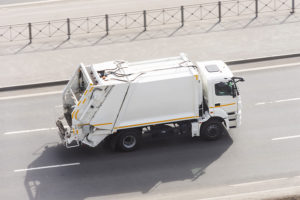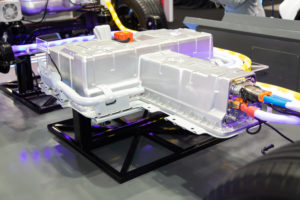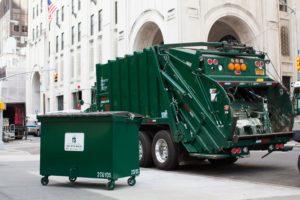Transportation is the biggest source of greenhouse gas (GHG) emissions in the US, and despite modest progress we are still overly reliant on fossil fuels to run our vehicles. Heavy-duty trucks are the biggest emitters of the lot; though constituting only 4% of the vehicles on the road in the US, these trucks use 20% of all fuel and spit out almost a quarter of all greenhouse gasses from transportation.
 The estimated 180,000 waste trucks that make up the US fleet of waste disposal vehicles must become more sustainable if we are to meet our ambitious climate goal of cutting emissions by 50-52% by 2030 (from 2005 levels). There is currently no catch-all solution to achieving this feat, but legislative pressure and a range of low- or no-carbon renewable fuel solutions are helping heavy-duty waste trucks move towards a greener future.
The estimated 180,000 waste trucks that make up the US fleet of waste disposal vehicles must become more sustainable if we are to meet our ambitious climate goal of cutting emissions by 50-52% by 2030 (from 2005 levels). There is currently no catch-all solution to achieving this feat, but legislative pressure and a range of low- or no-carbon renewable fuel solutions are helping heavy-duty waste trucks move towards a greener future.
Here then, we explore how a combination of technology, alongside better infrastructure planning and legislation, are key to reducing greenhouse gas emissions within the waste management industry.
Optimizing Existing Collection Infrastructure
Among the many issues facing waste management in the US, industry fragmentation ranks highly. Put simply, the sheer number of waste management service providers operating across the country, combined with often inconsistent facilities available at waste processing plants, make the collection and subsequent diversion of waste materials expensive, inefficient, and ultimately, wasteful.
Each state operates a different set of recycling rules, with a variety of materials either accepted or not accepted within both curbside and commercial recycling programs. Often, this is linked to the types of facility available within the area, but it is also tied into how waste management service providers operate. Today, waste management collection in cities and states across the US is rarely coordinated, with companies vying for business and “doubling up” collection routes as they service individual businesses or citizens.
This means trucks from different companies criss-cross any given area serving their clients. However, with the introduction of the NYC Commercial Waste Zones legislation in 2019, there is hope that more efficient approaches to waste collection and management can be achieved.
The CWZ program will divide the city into 20 zones, each served by up to three carters, instantly reducing the amount of truck traffic within the city by reducing the need for service providers “double up”. When these plans come into effect, businesses will only have a small pool of service providers to choose from in their area, preventing the endless procession of uncoordinated waste trucks from producing unnecessary greenhouse gases as they serve the same area.
Low- and No-Carbon Fuels
The short answer to the outsized problem of waste truck emissions is that we must find clean, renewable fuel sources to power trucks in place of the high-carbon, diesel fleets we have at present. And while the solution may vary depending on the locality and the proximity of resources, there is a grounded hope that it is possible to outstrip petroleum-based fuel in every area of concern for truck operators; the impact on the climate and public air quality, as well as the business costs of switching fuel/vehicles, and the vehicle performance.
Renewable Natural Gas as A Carbon-Negative Fuel Source
Renewable Natural Gas (RNG) fueled trucks are the most convincing solution for lowering emissions from waste disposal because they kill two birds with one stone. Not only is RNG almost chemically identical to fossil fuel derived natural gas, meaning it can be subbed into existing diesel engines, it is made out of the very same organic food waste that refuse trucks spend time and energy carting around. The RNG production process relies on the (growing) availability of anaerobic digesters, which convert wastewater and organic food waste into a renewable fuel. Because the 10,000 US trucks running on RNG emit fewer greenhouse gasses than the anaerobic digestion captures, it becomes the only net carbon-negative fuel available today.
 RNG therefore addresses our considerable municipal solid waste (MSW) problem by converting a methane-emitting waste stream into a carbon-negative fuel. And in this it responds directly to one of the biggest concerns arising from COP26 – the threat of methane gas from organic waste disposal. In 2021 the US and Europe went so far as to join hands on the Global Methane Pledge to cut their methane output by 30% by 2030 (from 2020 levels). RNG is a sizable stride toward meeting it.
RNG therefore addresses our considerable municipal solid waste (MSW) problem by converting a methane-emitting waste stream into a carbon-negative fuel. And in this it responds directly to one of the biggest concerns arising from COP26 – the threat of methane gas from organic waste disposal. In 2021 the US and Europe went so far as to join hands on the Global Methane Pledge to cut their methane output by 30% by 2030 (from 2020 levels). RNG is a sizable stride toward meeting it.
While the Environmental Protection Agency (EPA) continues to tighten rules around heavy-duty truck emissions and regulators clamp down on organic food waste disposal, NRG emerges as the most sensible and commercially viable alternative to diesel. However, while RNG is already widespread adoption, there are other, less tried and tested options on the horizon.
Battery Electric Vehicles
The EPA’s third phase of regulation around heavy-duty truck emissions will be announced at the end of 2022 and will pertain to vehicle models from 2027 onwards. It can be expected to involve a concerted push toward new, clean vehicles rather than simply renewable fuels. This is where the long-held aspiration towards battery electric vehicles (BEVs) rears its head. Soberingly, Energy Vision’s comprehensive 2021 report into the sector estimates that only 50 fully electric waste trucks are currently in operation in the US, and that their cost still exceeds that of a diesel truck by 70%.

Source: rts.com
The wonderful reality of zero tailpipe emissions and silent operation from BEVs is appealing, particularly to noisy, polluted inner cities. But when we consider the life cycle emissions of BEV powered trucks we see only a 58% reduction in GHG compared to diesel trucks (versus a 50-300% reduction available from RNG). This is largely because most of the electricity supplied to electric vehicles is currently derived from fossil fuels. There are also valid concerns around the mining of virgin raw materials (e.g. cobalt and other metals) for the manufacture of lithium batteries, as well as the difficulty and reluctance in recycling them.
Renewable diesel, made from waste oils, is another fuel solution that can be substituted directly into existing diesel trucks and achieves a good reduction in life cycle emissions (60%) compared to regular diesel. Although it’s seeing a boom in California in response to the stringent Low Carbon Fuel Standard, the cost and availability of the fuel is a significant barrier to wide-spread adoption.
The other low-carbon fuel solutions on the horizon paint an equally dubious picture. Some of them, such as biodiesel, are considered a mere stop-gap until engines move away from petroleum-based diesel trucks. Diesel hybrid-electric vehicles (HEVs) haven’t lived up to their promises of large fuel-efficiency benefits over diesel, although the reduction in GHG emissions and modest fuel efficiency improvements has driven some adoption in the waste disposal industry.
Other Solutions – Producing Less Waste
 From the perspective of waste vehicle operators and legislators we can see that a focus on low- and no-carbon fuels is the main driver of GHG emission reduction. But from the business perspective, as the incentives pile up to cut waste streams, there are more ways in which we can contribute to a reduction in emissions from waste trucks.
From the perspective of waste vehicle operators and legislators we can see that a focus on low- and no-carbon fuels is the main driver of GHG emission reduction. But from the business perspective, as the incentives pile up to cut waste streams, there are more ways in which we can contribute to a reduction in emissions from waste trucks.
There is a direct cost to your business in producing waste and these days disposal is recognised as a last resort in sustainable waste management practices. Working with a sustainable waste management company like RTS not only ensures that the waste you end up with is minimal, but that it is disposed of with the least impact on the environment. This means rethinking our trucks, but it also means harnessing data and technology to streamline the disposal process, giving you actionable insights into your waste habits, and making sure that your business identifies new potential revenue streams from your waste.
Waste trucks are as essential as ever in keeping our businesses, towns and cities running smoothly. As the low-carbon fuel revolution continues to progress, with RNG the front runner in reducing waste truck emissions, the single greatest thing we can do as businesses is to reduce our own waste output. So, for more guidelines and information on reducing waste across your business visit our blog or speak to an advisor today.

